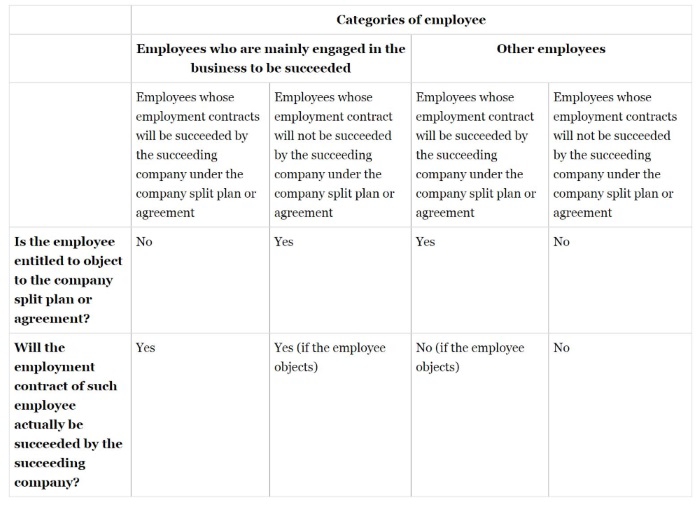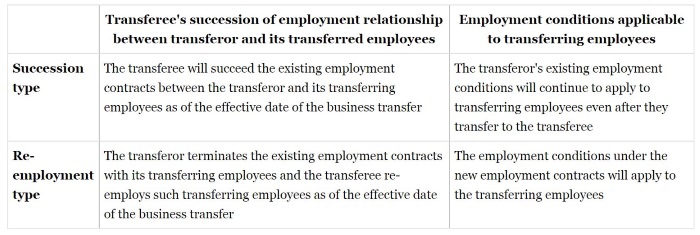- An M&A transaction's impact on the target's employees will vary depending on the structure of the transaction.
- A target's employment relationships are generally not affected by a purchase of its shares. However, as Japanese labour law imposes severe restrictions on dismissing employees or changing their employment conditions to ones which are disadvantageous without their consent, it is crucial that buyers conduct in-depth due diligence on a target to understand its employment conditions and benefits.
- In the case of a merger or company split, the employment contracts of the target (ie, merged or split company) will be succeeded by the buyer (ie, surviving or succeeding company) as part of a comprehensive succession of the target's assets and liabilities. After the merger or company split, two different types of employment condition under two different types of work rules and other employment-related regulations of two companies (ie, the target and buyer) will co-exist. As such, the buyer must consider how to integrate these in accordance with Japanese labour law. Further, a company split must follow certain processes designed to protect the employees of the target who are affected by the split, and certain categories of the target's employees are entitled to object to the company split plan or agreement.
- In the case of a business transfer, the buyer's (ie, transferee's) succession of existing employment contracts between the target (ie, transferor) and its transferring employees or the buyer's re-employment of such employees requires the employees' consent.
When conducting M&A transactions in Japan, one of the most important considerations is how to handle the target's employment relationships. In Japan, it is generally difficult for an employer to dismiss employees or change their employment conditions to ones which are disadvantageous without obtaining the employees' consent. Therefore, buyers must carefully examine a target's existing employment contracts and the effects of the M&A transaction on its employment relationships. The impact of the transaction on the target's employment contracts will vary depending on the transaction's structure. This article sets out such impact according to the type of M&A transaction.
Since the employer's status does not change by way of a transfer of shares in a target, employment relationships will not normally be affected by a share purchase. However, in such transactions, the buyer must be aware of the various restrictions which apply under Japanese labour law with respect to changing a target's employment relationships after a share purchase.
Share purchase agreements often include a post-closing covenant which requires the buyer to secure the employment of the target's employees and maintain their employment conditions for a certain period. Even without such a covenant, the dismissal of employees is severely restricted under Japanese labour law; employers can dismiss employees only if objectively reasonable grounds exist and such dismissal is deemed appropriate under general societal terms.(1) Employers are also generally prohibited from changing employment conditions to ones which are disadvantageous to employees without obtaining the employees' consent.(2)
Due to these restrictions, it is crucial for buyers to conduct in-depth due diligence on the target in order to understand its employment conditions and benefits.
In a merger, the merged company will be dissolved and all of its assets and liabilities will be comprehensively succeeded by the surviving company (in case of an absorption-type merger) or the newly incorporated company (in case of a consolidation-type merger). The surviving company will automatically succeed the existing employment contracts of the merged company as of the effective date of the merger.
Therefore, as a result of a merger, two different types of employment condition under two different types of work rules and other employment-related regulations of two companies will co-exist within the surviving company (ie, the existing employment conditions of the surviving company and the employment conditions succeeded from the merged company).
After an M&A transaction, the surviving company must normally take measures to integrate the employment conditions through the amendment of its work rules. Under Japanese labour law, a company can change its work rules to ones which are disadvantageous to employees only if such change is deemed to be reasonable in light of:
- the extent of the disadvantage to employees;
- the need to change the employment conditions;
- the appropriateness of the contents of the amended work rules;
- the status of negotiations with the labour union (among other parties); or
- any other circumstances pertaining to the change in work rules.(3)
A change of work rules also requires discussions with the relevant labour union or employee representative. In order to avoid any disputes with employees or the labour union, the employment conditions of the surviving company and the merged company are often integrated by including only those employment conditions which are favourable to employees. However, such integration of employment conditions might increase labour costs.
In Japan, a company split can be an incorporation-type company split or an absorption-type company split. In the case of the former, all or some of the splitting company's assets and liabilities (including its employment contracts) will be comprehensively succeeded by the newly incorporated company in accordance with the incorporation-type company split plan. In the case of the latter, the splitting company's assets and liabilities will be comprehensively succeeded by the succeeding company in accordance with the absorption-type company split agreement.
In a company split, the splitting company must follow certain processes to protect affected employees. The Act on the Succession to Labour Contracts Upon Company Split requires a splitting company to speak to the relevant labour union or employee representative in order to gain such employees' cooperation.(4) The act also requires the splitting company to provide written notice to employees:
- whose employment contracts will be succeeded by the succeeding company; and
- who are mainly engaged in the business to be succeeded.
Such notice must also be made to a labour union. Employees who receive notice from the splitting company can object to the company split plan or agreement if:
- they are mainly engaged in the business to be succeeded and their employment contract will not be succeeded by the succeeding company under the company split plan or agreement. In this case, such employees can require their employment contract to be succeeded by the succeeding company in their objection; or
- they are not mainly engaged in the business to be succeeded and their employment contract will be succeeded by the succeeding company under the company split plan or agreement. In this case, such employees can prevent their employment contract from being succeeded by the succeeding company in their objection.
Therefore, the list of employees who will be succeeded by the succeeding company under a company split plan or agreement might change as a result of any objections made by the employees described above.
The issue of the integration of employment conditions (as discussed under "Mergers") must also be considered in the case of a company split.
In sharp contrast to a merger or company split where the target's assets and liabilities are comprehensively succeeded by the surviving or succeeding company, a business transfer will be made under a business transfer agreement between the transferor and transferee. Such agreement will specify certain assets or liabilities, and the transferor and transferee must follow certain procedures for each in order for the transferee to succeed such asset or liability (eg, procurement of consent from a counterparty of each contract to be transferred, together with such asset or liability). Therefore, the transferor's employment relationships can be transferred to the transferee only if each affected employee consents to such transfer.
In a business transfer, the transferee's succession of the transferor's employment relationships with its transferring employees can take two forms (ie, the 'succession type' or the 're-employment type'), as described below. In both cases, the transferor and transferee often agree an arrangement to prevent the transfer from adversely affecting transferring employees.
In general, the transferor and transferee can choose which employees will be transferred to the transferee by way of a business transfer. However, the Japanese courts might not approve a part of the effect of a business transfer which might cause disadvantages to employees if:
- the transferee succeeded the employment relationship between the transferor and its transferring employees in order to oust specific employees of the transferor; or
- the transferee re-employs only transferring employees who consent to disadvantageous employment conditions.
Therefore, the transferor and transferee must carefully consider the purpose of the business transfer and ensure that neither of the above scenarios apply. The Ministry of Health, Labour and Welfare has issued guidelines on the matters which must be taken into account to protect employees in a business transfer.(5)
Another matter to be considered with regard to the employment relationships of the target in an M&A transaction is retirement allowance and corporate pension plans.
In Japan, M&A transactions often require the elimination of or a change in the target's existing retirement allowance or corporate pension plans or the conversion of the target's corporate pension plan into another type of corporate pension plan managed by the buyer. For example, where a company withdraws from a group of companies which operates a corporate pension system only for employees within such group as a result of an M&A transaction, it might be difficult to maintain the current corporate pension system. To eliminate, change or convert a corporate pension plan, certain regulatory procedures must be followed (eg, the Ministry of Health, Labour and Welfare's permission must be obtained). Such procedures might take a long time to complete after the closure of the M&A transaction. Moreover, since the existing retirement allowance and corporate pension plans in Japan will be part of the employment conditions prescribed in the employment contracts between employers and employees, any change in such retirement allowance or corporate pension plans which is disadvantageous to employees will generally require each employee's consent under the Labour Contract Act.
As Japanese labour law severely restricts any change in employment conditions which is disadvantageous to employees, as well as the dismissal of employees, employment relationships are a key issue in all M&A transactions. In order to ensure that an M&A transaction succeeds, it is necessary to understand the Japanese laws and regulations which apply to employment relationships when choosing the type of transaction and negotiating with the counterparty.
Endnotes
(1) Article 16 of the Labour Contract Act (Act 128 of 5 December 2007).
(2) Article 9 of the Labour Contract Act.
(3) Articles 9 and 10 of the Labour Contract Act.
(4) Article 5 of the Supplementary Provisions of the Act Revising a Portion of the Commercial Code, Etc. (Act 90/2000) also requires the splitting company to have individual discussions.
(5) The Guidelines Concerning Matters to Be Taken into Account by Companies etc in Assignment of Business and Mergers", which apply as of 1 September 2016, set out a process for protecting employees in M&A transactions.







